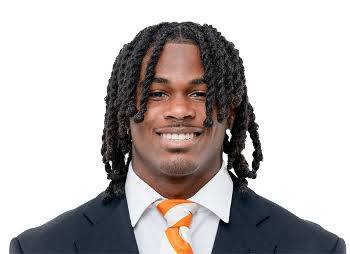The Tennessee Volunteers’ defensive backs are showcasing versatility and depth as they prepare for the upcoming 2025 college football season. Led by returning starters Jermod McCoy and Rickey Gibson III at cornerback, and Andre Turrentine at safety, the Vols’ secondary is looking to build on a strong 2024 season where they allowed the fewest explosive plays in FBS. With a mix of veteran leadership and emerging young talent, this unit is poised to be one of the most formidable in college football.
Jermod McCoy, a junior transfer, has quickly established himself as one of the top defensive backs in the nation. Last season, he led the Vols in pass deflections (7) and interceptions (4), earning a reputation as a lockdown corner. His elite coverage skills and ball-hawking ability made him a projected first-round NFL draft pick before he suffered a torn ACL in January. The University of Tennessee Athletics confirmed his return to practice as of August 8th, but his full recovery timeline remains uncertain. If McCoy can regain his pre-injury form, he will be a critical piece of Tennessee’s defense, capable of neutralizing opposing teams’ top receivers.
Opposite McCoy, Rickey Gibson III is coming off a career year in 2024. The junior cornerback recorded 32 tackles, five pass breakups, and a forced fumble, demonstrating his growth as a complete defensive back. Defensive backs coach Willie Martinez has praised Gibson’s consistency, improved ball skills, and leadership, particularly in mentoring younger players. Gibson’s ability to play both man and zone coverage at a high level gives Tennessee flexibility in its defensive schemes. His development into a reliable No. 2 cornerback allows the Vols to match up effectively against high-powered passing attacks.
At safety, redshirt senior Andre Turrentine provides stability and experience. A transfer who has seamlessly adapted to Tennessee’s system, Turrentine is known for his football IQ, physicality, and ability to communicate coverages. His presence in the back end is crucial for organizing the defense, especially when facing complex offensive schemes. Turrentine’s leadership will be invaluable as the Vols integrate younger players into the rotation.
One of the most intriguing players in the secondary is sophomore Boo Carter, who is expected to take over the Star position (nickelback). Carter’s combination of speed, agility, and tackling ability makes him an ideal fit for the role, which requires covering slot receivers, blitzing, and supporting against the run. His versatility allows Tennessee to stay in its base 4-2-5 defense without sacrificing coverage or run support. Carter’s emergence could be a game-changer, as elite nickelbacks are increasingly vital in modern college football.
The safety position also boasts impressive depth, with sophomores Kaleb Beasley and Edrees Farooq competing for starting roles. Beasley, a former highly touted recruit, has shown flashes of his potential with his range and ball skills. Farooq, another rising talent, brings physicality and instincts to the secondary. Both players have benefited from a year in the system and are poised to take on larger roles in 2025. Their development will be key in ensuring the Vols don’t experience a drop-off when rotating players in and out of the lineup.
Among the newcomers, true freshman Ty Redmond has been a standout in spring and fall camps. Coaches have raved about his consistency, playmaking ability, and quick grasp of the defensive scheme. Redmond’s versatility allows him to play multiple positions in the secondary, making him a valuable asset as the season progresses. While freshmen often face a steep learning curve, Redmond’s early performances suggest he could earn significant playing time sooner rather than later.
Tennessee’s projected defensive depth chart reflects both talent and flexibility. In the multiple 4-2-5 scheme, the cornerback spots are anchored by McCoy and Gibson, with Colton Hood and Jalen McMurray providing depth. At safety, Turrentine and Beasley are likely starters, with Marcus Goree Jr. and Farooq pushing for snaps. Carter holds down the nickel spot, backed up by Jourdan Thomas. This depth ensures that the Vols can withstand injuries and fatigue over the course of a long season.
Defensive backs coach Willie Martinez has emphasized the importance of versatility within the secondary. The ability to move players like Redmond between corner and safety, or Carter between nickel and outside corner, allows Tennessee to adjust to various offensive formations. This adaptability will be crucial in a conference like the SEC, where teams deploy everything from power run schemes to spread passing attacks. Martinez’s experience developing NFL-caliber defensive backs should further elevate this group’s performance.
Looking ahead, the Volunteers’ secondary has the potential to be among the best in the nation. The return of McCoy and Gibson gives Tennessee two elite cover corners, while Turrentine’s leadership stabilizes the safety group. Young players like Carter, Beasley, and Redmond add explosiveness and depth, ensuring the unit remains strong for years to come. If McCoy makes a full recovery and the younger players continue to develop, this secondary could be the backbone of a championship-caliber defense.
The 2025 season will present challenges, including matchups against high-octane offenses in the SEC. However, with a deep and versatile defensive backfield, the Volunteers are well-equipped to handle whatever comes their way. The combination of experience, talent, and coaching makes this group one to watch as Tennessee pursues its goals this fall. Fans should be excited about the potential of this secondary to make game-changing plays and help lead the Vols to success.



